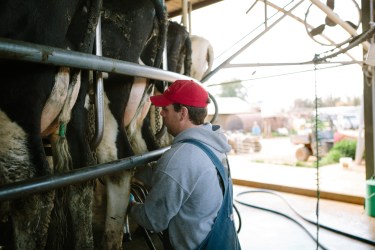By Caroline Groves
We are now in uncharted waters and milk buyers are having to deal with surplus milk. The reason for the situation is described in detail, in a blog, here by my colleague Tim Harper.
We have put together some guidance that I hope you will find useful. Of course these are general guidelines and the best response for you will depend on the intentions of your milk buyer and your own circumstances. Like most people I also have to follow the lock down guidance but that doesn’t mean I can’t give you advice and help you decide what is the best thing to do.
Diet Options
| Potential Response | What problem this advice addresses | What you need to do to make it happen | Situation it is most suited to | |
| Reduce feed rates where possible | Reduction of milk production and feed cost per litre of production | Target cows or groups where it will have the lowest long term impact Group cows by stage of lactation Review milk and fertility records | All herds Cows going out to grass Less suited to fresh cows Review cows over 110 days in milk and in calf | |
| Reduce protein input | Will reduce yield without reducing energy intake and compromising fertility It also saves money on feed costs to offset the loss of milk sales | Will depend – easiest way is to amend the outside ration e.g. cut the protein concentrate and replace with energy based feed or increase forage supply | Herds where straights are being fed High yielding cows | |
| Feed lower quality forage | Reduces yield Better forage saved for when needed | Feed the lower quality forage under the advice of a nutritionist or consultant | All herds, especially those housed all year round Could have adverse consequences especially for early lactation cows | |
| Get cows out to grass where possible | Reduce feed costs, potentially reduce labour requirements if staffing levels are an issue, fewer cubicles to bed etc | Get cows outside and use electric fences to maximise grass utilisation Ensure they have access to water if grazing is not the norm! Have confidence in grazed grass: latest samples show ME over 12 | Herds that have access to grazing If not consider zero grazing Less suited to very high yielding cows Works well if farm has shedding gate to allow lower yielding animals access to pasture |
Drying Off and Culling Options
| Potential Response | What problem this advice addresses | What you need to do to make it happen | Situation it is most suited to | |
| Cull least profitable cows | Reduces cow numbers and is an extra source of income for now if can be sold | Look at cell count data and identify chronics; look at fertility reports and identify cows struggling to get in calf If market not available consider grazing | Cows with high cell count problems, especially Tesco farmers; high-yielding herds which may be at risk of having to dump milk | |
| Dry some cows off early if possible | Reduces daily milk output, saves feed, reduces milking time and costs | Identify lower yielding cows check individual SCC for appropriate treatment | All herds Need to be careful not to let dry cows put on too much condition as this will lead to Ketosis, calving problems and infertility |
Other Options
| Potential Response | What problem this advice addresses | What you need to do to make it happen | Situation it is most suited to | |
| Feed whole milk to calves | Reduces volume going into the tank Saves on purchased milk powder | Change protocol and potentially house beef calves separately to heifer calves | Small herds with smaller overall volumes and beef calves and all flying herds Be careful not to break Johne’s safeguards | |
| Take advantage of government support | Replaces lost income Provides debt relief | Will depend on your circumstances and your eligibility Seek advice | Read more information here on how to deal with cash shortages and income support available for farmers | |
| Seek alternative market | Direct sales at a premium price But may need significant capital outlay | Would need to obtain processing or vending equipment so not a short term fix | If you are near a populated area |
Business Management Options
| Potential Response | What problem this advice addresses | What you need to do to make it happen | Situation it is most suited to | |
| Partial Budgets | Allows each of the options you are faced with to be evaluated | Estimate extra costs and income lost and deduct this from income gained and costs saved | Any change in practice that is going to have a financial impact | |
| Budget short and medium term to assess cash requirements | Knowing your peak borrowing need and to choose the most promising plan | Budget with new milk price Budget with various options – to show financial impact of change and choose the right one | Any farms which have had a milk price drop or reduction in demand All businesses needing more funding than bank has agreed |
We really appreciate it is not easy to sort these problems out on your own and that is why I really encourage you to get in touch with us – we will do our best to help.








